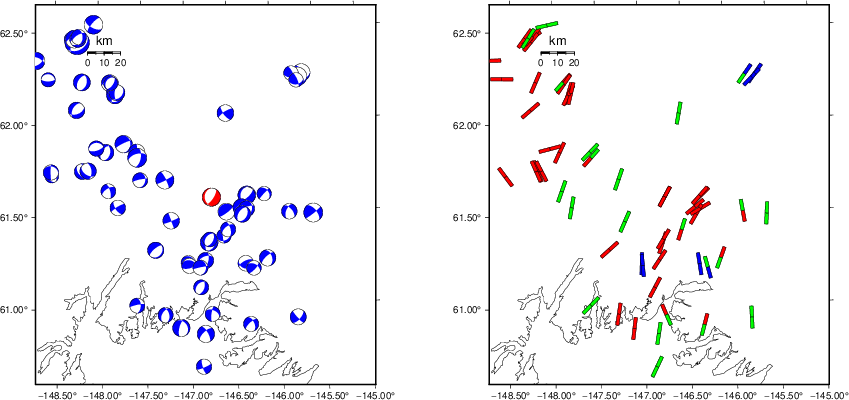Location
Location ANSS
The ANSS event ID is ak0104ljdsz2 and the event page is at
https://earthquake.usgs.gov/earthquakes/eventpage/ak0104ljdsz2/executive.
2010/04/10 09:47:57 61.597 -146.737 43.6 4.5 Alaska
Focal Mechanism
USGS/SLU Moment Tensor Solution
ENS 2010/04/10 09:47:57:0 61.60 -146.74 43.6 4.5 Alaska
Stations used:
AK.BMR AK.BRLK AK.CCB AK.DDM AK.DHY AK.DIV AK.DOT AK.EYAK
AK.KLU AK.KTH AK.MCK AK.MDM AK.PAX AK.PPLA AK.RAG AK.RC01
AK.RND AK.SCM AK.SSN AK.TRF AK.WRH AT.PMR IU.COLA XZ.BAGL
XZ.BARK XZ.BARN XZ.GOAT XZ.ISLE XZ.KHIT XZ.MESA XZ.RKAV
XZ.VRDI
Filtering commands used:
cut o DIST/3.3 -30 o DIST/3.3 +50
rtr
taper w 0.1
hp c 0.02 n 3
lp c 0.05 n 3
Best Fitting Double Couple
Mo = 6.84e+22 dyne-cm
Mw = 4.49
Z = 51 km
Plane Strike Dip Rake
NP1 35 70 -75
NP2 177 25 -125
Principal Axes:
Axis Value Plunge Azimuth
T 6.84e+22 24 113
N 0.00e+00 14 210
P -6.84e+22 62 328
Moment Tensor: (dyne-cm)
Component Value
Mxx -1.66e+21
Mxy -1.43e+22
Mxz -3.40e+22
Myy 4.41e+22
Myz 3.80e+22
Mzz -4.25e+22
###-----------
####------------------
####----------------------##
####-----------------------###
####------------------------######
####-------------------------#######
#####--------- ------------#########
#####---------- P -----------###########
#####---------- -----------###########
#####------------------------#############
#####-----------------------##############
#####----------------------###############
#####--------------------#################
#####------------------########## ####
#####----------------############ T ####
#####--------------############# ###
#####-----------####################
#####--------#####################
####-----#####################
############################
----##################
----##########
Global CMT Convention Moment Tensor:
R T P
-4.25e+22 -3.40e+22 -3.80e+22
-3.40e+22 -1.66e+21 1.43e+22
-3.80e+22 1.43e+22 4.41e+22
Details of the solution is found at
http://www.eas.slu.edu/eqc/eqc_mt/MECH.NA/20100410094757/index.html
|
Preferred Solution
The preferred solution from an analysis of the surface-wave spectral amplitude radiation pattern, waveform inversion or first motion observations is
STK = 35
DIP = 70
RAKE = -75
MW = 4.49
HS = 51.0
The NDK file is 20100410094757.ndk
The waveform inversion is preferred.
Magnitudes
Given the availability of digital waveforms for determination of the moment tensor, this section documents the added processing leading to mLg, if appropriate to the region, and ML by application of the respective IASPEI formulae. As a research study, the linear distance term of the IASPEI formula
for ML is adjusted to remove a linear distance trend in residuals to give a regionally defined ML. The defined ML uses horizontal component recordings, but the same procedure is applied to the vertical components since there may be some interest in vertical component ground motions. Residual plots versus distance may indicate interesting features of ground motion scaling in some distance ranges. A residual plot of the regionalized magnitude is given as a function of distance and azimuth, since data sets may transcend different wave propagation provinces.
ML Magnitude

Left: ML computed using the IASPEI formula for Horizontal components. Center: ML residuals computed using a modified IASPEI formula that accounts for path specific attenuation; the values used for the trimmed mean are indicated. The ML relation used for each figure is given at the bottom of each plot.
Right: Residuals from new relation as a function of distance and azimuth.

Left: ML computed using the IASPEI formula for Vertical components (research). Center: ML residuals computed using a modified IASPEI formula that accounts for path specific attenuation; the values used for the trimmed mean are indicated. The ML relation used for each figure is given at the bottom of each plot.
Right: Residuals from new relation as a function of distance and azimuth.
Context
The left panel of the next figure presents the focal mechanism for this earthquake (red) in the context of other nearby events (blue) in the SLU Moment Tensor Catalog. The right panel shows the inferred direction of maximum compressive stress and the type of faulting (green is strike-slip, red is normal, blue is thrust; oblique is shown by a combination of colors). Thus context plot is useful for assessing the appropriateness of the moment tensor of this event.
Waveform Inversion using wvfgrd96
The focal mechanism was determined using broadband seismic waveforms. The location of the event (star) and the
stations used for (red) the waveform inversion are shown in the next figure.
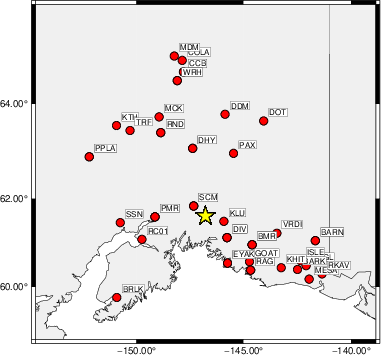
|
|
Location of broadband stations used for waveform inversion
|
The program wvfgrd96 was used with good traces observed at short distance to determine the focal mechanism, depth and seismic moment. This technique requires a high quality signal and well determined velocity model for the Green's functions. To the extent that these are the quality data, this type of mechanism should be preferred over the radiation pattern technique which requires the separate step of defining the pressure and tension quadrants and the correct strike.
The observed and predicted traces are filtered using the following gsac commands:
cut o DIST/3.3 -30 o DIST/3.3 +50
rtr
taper w 0.1
hp c 0.02 n 3
lp c 0.05 n 3
The results of this grid search are as follow:
DEPTH STK DIP RAKE MW FIT
WVFGRD96 1.0 40 40 -80 3.81 0.1852
WVFGRD96 2.0 35 40 -90 3.91 0.2360
WVFGRD96 3.0 35 40 -90 3.98 0.2559
WVFGRD96 4.0 40 40 -85 4.02 0.2620
WVFGRD96 5.0 40 40 -85 4.04 0.2513
WVFGRD96 6.0 65 45 -60 4.04 0.2289
WVFGRD96 7.0 70 45 -55 4.04 0.2109
WVFGRD96 8.0 60 40 -70 4.09 0.2278
WVFGRD96 9.0 30 90 -70 4.03 0.2120
WVFGRD96 10.0 215 85 70 4.04 0.2298
WVFGRD96 11.0 30 90 -65 4.04 0.2463
WVFGRD96 12.0 30 90 -65 4.05 0.2612
WVFGRD96 13.0 210 90 65 4.05 0.2754
WVFGRD96 14.0 30 90 -65 4.06 0.2893
WVFGRD96 15.0 30 90 -65 4.07 0.3019
WVFGRD96 16.0 30 90 -65 4.07 0.3139
WVFGRD96 17.0 210 90 65 4.08 0.3254
WVFGRD96 18.0 30 90 -65 4.09 0.3361
WVFGRD96 19.0 210 90 65 4.10 0.3461
WVFGRD96 20.0 20 85 -65 4.12 0.3560
WVFGRD96 21.0 210 90 65 4.12 0.3638
WVFGRD96 22.0 25 85 -65 4.13 0.3742
WVFGRD96 23.0 25 85 -65 4.14 0.3832
WVFGRD96 24.0 25 85 -65 4.15 0.3918
WVFGRD96 25.0 20 80 -65 4.17 0.4004
WVFGRD96 26.0 20 80 -70 4.17 0.4091
WVFGRD96 27.0 20 80 -70 4.18 0.4178
WVFGRD96 28.0 20 80 -70 4.19 0.4258
WVFGRD96 29.0 25 80 -70 4.20 0.4336
WVFGRD96 30.0 20 75 -70 4.22 0.4415
WVFGRD96 31.0 25 75 -70 4.22 0.4499
WVFGRD96 32.0 25 75 -70 4.23 0.4579
WVFGRD96 33.0 25 75 -70 4.24 0.4653
WVFGRD96 34.0 25 75 -70 4.24 0.4718
WVFGRD96 35.0 30 75 -70 4.25 0.4775
WVFGRD96 36.0 25 70 -70 4.27 0.4834
WVFGRD96 37.0 25 70 -70 4.28 0.4888
WVFGRD96 38.0 25 70 -70 4.28 0.4935
WVFGRD96 39.0 30 70 -70 4.29 0.4973
WVFGRD96 40.0 30 75 -75 4.41 0.4925
WVFGRD96 41.0 30 75 -75 4.42 0.4966
WVFGRD96 42.0 30 75 -75 4.42 0.4997
WVFGRD96 43.0 35 75 -75 4.43 0.5026
WVFGRD96 44.0 30 70 -75 4.45 0.5064
WVFGRD96 45.0 30 70 -75 4.45 0.5097
WVFGRD96 46.0 30 70 -80 4.46 0.5125
WVFGRD96 47.0 30 70 -80 4.47 0.5148
WVFGRD96 48.0 35 70 -75 4.47 0.5166
WVFGRD96 49.0 30 70 -80 4.48 0.5179
WVFGRD96 50.0 35 70 -75 4.48 0.5189
WVFGRD96 51.0 35 70 -75 4.49 0.5192
WVFGRD96 52.0 35 70 -75 4.49 0.5190
WVFGRD96 53.0 35 70 -75 4.50 0.5187
WVFGRD96 54.0 35 70 -75 4.50 0.5178
WVFGRD96 55.0 35 70 -75 4.51 0.5165
WVFGRD96 56.0 35 70 -75 4.51 0.5146
WVFGRD96 57.0 35 70 -75 4.52 0.5126
WVFGRD96 58.0 35 70 -75 4.52 0.5103
WVFGRD96 59.0 35 70 -75 4.52 0.5075
The best solution is
WVFGRD96 51.0 35 70 -75 4.49 0.5192
The mechanism corresponding to the best fit is
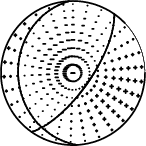
|
|
Figure 1. Waveform inversion focal mechanism
|
The best fit as a function of depth is given in the following figure:
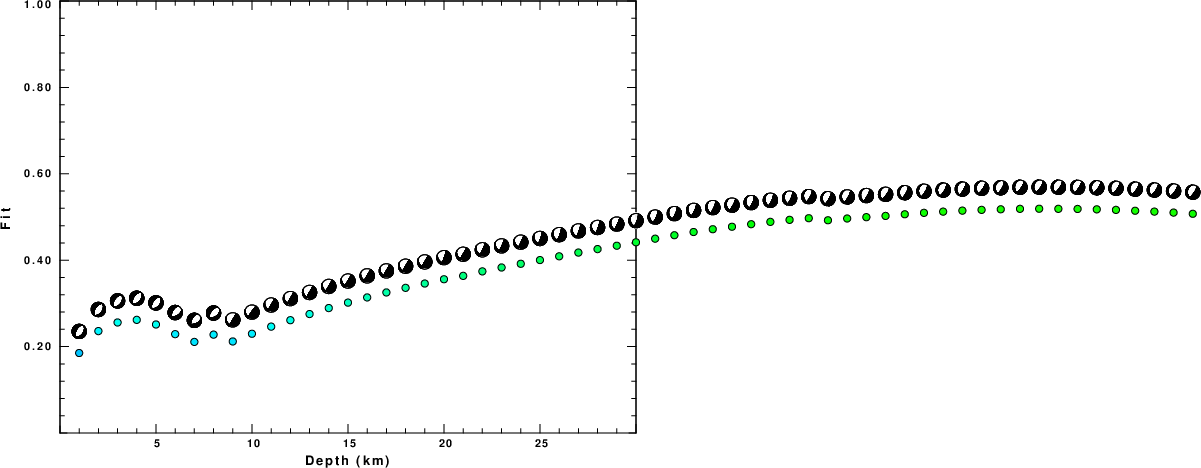
|
|
Figure 2. Depth sensitivity for waveform mechanism
|
The comparison of the observed and predicted waveforms is given in the next figure. The red traces are the observed and the blue are the predicted.
Each observed-predicted component is plotted to the same scale and peak amplitudes are indicated by the numbers to the left of each trace. A pair of numbers is given in black at the right of each predicted traces. The upper number it the time shift required for maximum correlation between the observed and predicted traces. This time shift is required because the synthetics are not computed at exactly the same distance as the observed, the velocity model used in the predictions may not be perfect and the epicentral parameters may be be off.
A positive time shift indicates that the prediction is too fast and should be delayed to match the observed trace (shift to the right in this figure). A negative value indicates that the prediction is too slow. The lower number gives the percentage of variance reduction to characterize the individual goodness of fit (100% indicates a perfect fit).
The bandpass filter used in the processing and for the display was
cut o DIST/3.3 -30 o DIST/3.3 +50
rtr
taper w 0.1
hp c 0.02 n 3
lp c 0.05 n 3
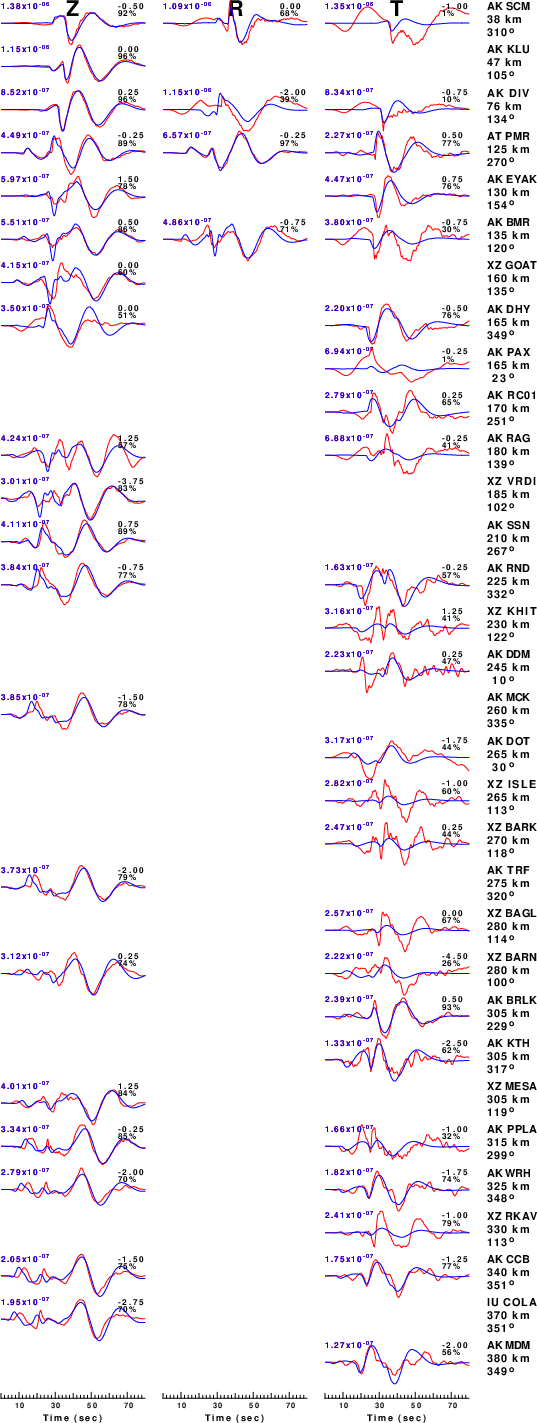
|
|
Figure 3. Waveform comparison for selected depth. Red: observed; Blue - predicted. The time shift with respect to the model prediction is indicated. The percent of fit is also indicated. The time scale is relative to the first trace sample.
|
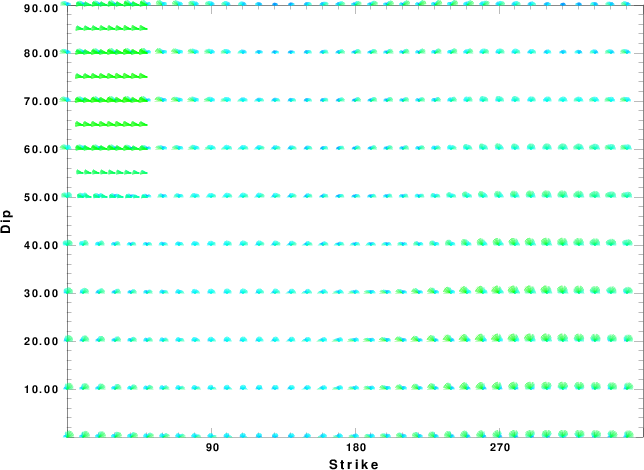
|
|
Focal mechanism sensitivity at the preferred depth. The red color indicates a very good fit to the waveforms.
Each solution is plotted as a vector at a given value of strike and dip with the angle of the vector representing the rake angle, measured, with respect to the upward vertical (N) in the figure.
|
A check on the assumed source location is possible by looking at the time shifts between the observed and predicted traces. The time shifts for waveform matching arise for several reasons:
- The origin time and epicentral distance are incorrect
- The velocity model used for the inversion is incorrect
- The velocity model used to define the P-arrival time is not the
same as the velocity model used for the waveform inversion
(assuming that the initial trace alignment is based on the
P arrival time)
Assuming only a mislocation, the time shifts are fit to a functional form:
Time_shift = A + B cos Azimuth + C Sin Azimuth
The time shifts for this inversion lead to the next figure:
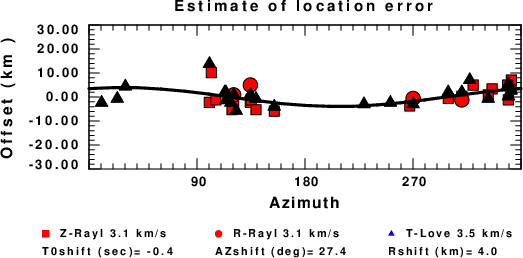
The derived shift in origin time and epicentral coordinates are given at the bottom of the figure.
Velocity Model
The WUS.model used for the waveform synthetic seismograms and for the surface wave eigenfunctions and dispersion is as follows
(The format is in the model96 format of Computer Programs in Seismology).
MODEL.01
Model after 8 iterations
ISOTROPIC
KGS
FLAT EARTH
1-D
CONSTANT VELOCITY
LINE08
LINE09
LINE10
LINE11
H(KM) VP(KM/S) VS(KM/S) RHO(GM/CC) QP QS ETAP ETAS FREFP FREFS
1.9000 3.4065 2.0089 2.2150 0.302E-02 0.679E-02 0.00 0.00 1.00 1.00
6.1000 5.5445 3.2953 2.6089 0.349E-02 0.784E-02 0.00 0.00 1.00 1.00
13.0000 6.2708 3.7396 2.7812 0.212E-02 0.476E-02 0.00 0.00 1.00 1.00
19.0000 6.4075 3.7680 2.8223 0.111E-02 0.249E-02 0.00 0.00 1.00 1.00
0.0000 7.9000 4.6200 3.2760 0.164E-10 0.370E-10 0.00 0.00 1.00 1.00
Last Changed Sat Apr 27 11:54:42 AM CDT 2024


